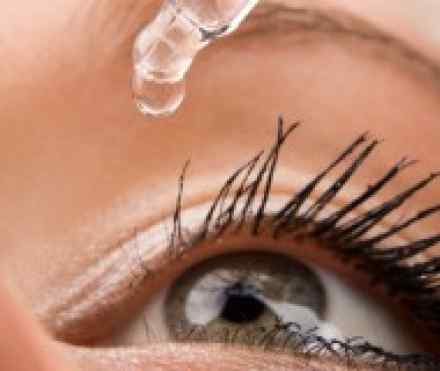
What is it?
- While a sad movie or a wedding can get your tears noticeably flowing, your eyes are actually producing tears all the time. Healthy eyes are continuously covered by fluid — a tear film designed to remain stable between blinks. A stable tear film prevents dry eyes and allows your eyes to maintain clear, comfortable vision.
- Decreased production of fluids from your tear glands can destabilize the tear film, allowing it to break down rapidly and create dry spots on the surface of your eyes. An imbalance in the substances that make up the tear film also causes dry eyes.
- Dry eyes are a common source of discomfort. Treatment of dry eyes aims to restore a more normal tear film to minimize your dryness, blurred vision and discomfort.
Symptoms
Signs and symptoms of dry eyes, which usually affect both eyes, may include:
- A stinging, burning or scratchy sensation in your eyes
- Stringy mucus in or around your eyes
- Increased eye irritation from smoke or wind
- Eye fatigue after short periods of reading
- Sensitivity to light
- Difficulty wearing contact lenses
- Tearing
- Blurred vision, often worsening at the end of the day or after visually focusing for a prolonged period on a nearby task
Causes
Tears are made up of more than just water. They're a complex mixture of water, fatty oils, proteins, electrolytes, bacteria-fighting substances and growth factors that regulate various cell processes. This mixture helps make the surface of your eyes smooth and clear. Without tears, good vision is impossible.
For some people, the cause of dry eyes is an imbalance in the composition of their tears. Other people don't produce enough tears to keep their eyes comfortably lubricated. Eyelid problems, medications and other causes, such as environmental factors, also can lead to dry eyes.
Poor tear quality
The tear film has three basic layers: oil, water and mucus. Problems with any of these layers can cause dry eye symptoms.
- Oil. The outer layer, produced by small glands on the edge of your eyelids (meibomian glands), contains fatty oils called lipids. These smooth the tear surface and slow evaporation of the middle watery layer. When the oil layer is abnormal, the watery layer evaporates too quickly. Dry eye problems are common in people whose meibomian glands are clogged. Meibomian dysfunction is more common in people with inflammation along the edge of their eyelids (blepharitis), rosacea and other skin disorders.
- Water. The middle layer, which is by far the thickest layer, is mostly water with a little bit of salt. This layer, produced by the tear glands (lacrimal glands), cleanses your eyes and washes away foreign particles or irritants. A shallow water layer can predispose you to tear film instability. If your eye produces only small, inadequate amounts of water, the oil and mucus layers can touch and cause the stringy discharge familiar to people with dry eyes.
- Mucus. The inner layer of mucus allows tears to spread evenly over the surface of your eyes. Dry spots form easily in any part of the front surface of the eye (cornea) that has patchy loss of the mucus layer.
Decreased tear production
Dry eyes are common, especially for people older than 40. Tear production tends to diminish as you get older. When you're unable to produce enough tears, your eyes become dry and easily irritated. The medical term for this condition is keratoconjunctivitis sicca (ker-uh-to-kun-junk-ti-VIE-tis sik-uh).
Although dry eyes can affect both men and women at any age, the condition is more common among women, especially after menopause. This may be due in part to hormonal changes. Damage to the tear glands from inflammation or radiation can hamper tear production. Dry eyes are also associated with some medical conditions such as diabetes, rheumatoid arthritis, lupus, scleroderma, Sjogren's syndrome and vitamin A deficiency.
Refractive eye surgeries such as laser-assisted in-situ keratomileusis (LASIK) also may cause decreased tear production and dry eyes. Symptoms of dry eyes related to these procedures are usually temporary.
Poor lid function
Through blinking — normally at a rate of about once every 12 seconds — your eyelids spread a continuous thin film of tears across the surface of your eyes. Problems with your eyelids can impair the complex blinking motion required to spread these tears, resulting in dry eyes. Eyelid problems that may develop as you age include an out-turning of the lids (ectropion) or an in-turning of the lids (entropion).
Blepharitis, an inflammation along the edge of the eyelids, also may cause your eyes to feel dry and scratchy.
Medications
The types of common medications, both prescription and over-the-counter (OTC), that can be the causes of dry eyes include:
- Diuretics, drugs commonly used to treat high blood pressure
- Angiotensin-converting enzyme (ACE) inhibitors used to treat high blood pressure
- Antihistamines and decongestants
- Sleeping pills
- Birth control pills
- Certain antidepressants
- Isotretinoin-type drugs for treatment of acne
- Opiate-based pain relievers, such as morphine
Other causes of dry eyes
Dry eyes can be worsened by exposure to many environmental conditions that have a drying effect, such as sun, wind, high altitude, a dry climate, hot blowing air and the dry air that commonly occurs in the cabins of commercial airplanes.
In addition, tasks that require intense visual concentration — such as working at a computer, driving or reading — tend to decrease your blink rate, thereby increasing tear evaporation.
Diagnosis
If your eyes feel dry and irritated, your eye doctor can test both the quantity and the quality of your tears.
Your doctor may measure your tear production using the Schirmer tear test. In this test, blotting strips of paper are placed under your lower eyelids. After five minutes your doctor measures the amount of strip soaked by your tears.
Other tests use special dyes in eyedrops to determine the surface condition of your eyes. Your doctor looks for staining patterns on the cornea and measures how long it takes before your tears evaporate.
Treatments and drugs
For most people with occasional or mild dry eyes symptoms, treatment involves over-the-counter eyedrops and other home remedies. If your dry eyes symptoms are persistent and more serious, your treatment options will depend on what's causing your dry eyes. Some conditions that cause dry eyes can be reversed or managed. Other treatments can improve your tear quality or stop your tears from quickly draining away from your eyes.
Treating the underlying cause of dry eyes
Your doctor will work to determine what's causing your dry eyes. In some cases these situations can be reversed. For instance, if a medication is causing your dry eyes, your doctor may recommend a different medication that doesn't cause that side effect.
If you have an eyelid condition, such as an anatomic abnormality or a condition that makes it difficult to close your eye completely when you blink, your doctor may refer you to an eye surgeon who specializes in plastic surgery of the eyelids (oculoplastic surgeon).
If your signs and symptoms suggest an autoimmune condition, such as rheumatoid arthritis or Sjogren's syndrome, your doctor may refer you to a rheumatologist for evaluation.
Medications
Prescriptions used to treat dry eyes include:
- Antibiotics to reduce eyelid inflammation. If inflammation along the edge of your eyelid keeps the oil glands from secreting oil into your tears, your doctor may recommend antibiotics to reduce inflammation. Antibiotics can be administered as eyedrops or ointment, or they can be taken in pill form.
- Prescription eyedrops to control cornea inflammation. Inflammation on the surface of your eye may be controlled with prescription eyedrops that contain the immune-suppressing medication cyclosporine or that contain corticosteroids to control inflammation.
- Prescription eye inserts that work like artificial tears. For people with moderate to severe dry eyes symptoms who can't use artificial tears, one option may be a tiny eye insert that looks like a clear grain of rice. Once a day, you place the hydroxypropyl cellulose insert between your lower eyelid and your eyeball. The insert dissolves slowly, releasing a substance that's used in eyedrops to lubricate your eye.
Closing your tear ducts to reduce tear loss
Your doctor may suggest treatment to keep your tears from leaving your eye too quickly. This can be done by partially or completely closing your tear ducts, which normally serve to drain tears away. Tear ducts can be plugged by:
- Tiny silicone plugs. The closure conserves both your own tears and artificial tears you may add. Silicone plugs can be removed or left in.
- A procedure that uses heat to close the tear ducts. In a more permanent procedure called thermal cautery, your doctor numbs the area with an anesthetic and then applies a hot wire that shrinks the tissues of the drainage area and causes scarring, which closes the tear duct.
Covering your eyes with a special contact lens
People with severe dry eyes may opt for special contact lenses. These contact lenses help protect or shield the surface of your eye, trapping moisture close to your eye in order to relieve your dry eyes symptoms. Ask your eye doctor whether these special lenses, called bandage lenses or corneal shields, are an option for you.
Lifestyle remedies
If you experience mild or occasional dry eyes symptoms, you may be able to manage your condition with over-the-counter eyedrops and frequent eyelid washing.
Adding tears with over-the-counter eyedrops
Mild cases of dry eyes may be relieved by over-the-counter artificial tears. A variety of artificial tears are available, so ask your doctor or eye doctor which drops might be best for you. Some ideas to help you select eyedrops include:
- Preservative vs. nonpreservative drops. Preservatives are added to some eyedrops to prolong shelf life. You can use eyedrops with preservatives up to four times a day. But using the preservative drops more often can cause eye irritation. Nonpreservative eyedrops come in packages that contain multiple single-use vials. After you use a vial, you must throw it away. If you rely on eyedrops more than four times a day, nonpreservative drops are safe.
- Drops vs. ointments. Lubricating eye ointments coat your eyes, providing longer lasting relief from dry eyes. But ointments are thick and can cloud your vision. For this reason, ointments are best used just before bedtime. Eyedrops can be used at any time and won't interfere with your vision.
How often you need to put eyedrops in your eyes will depend on your symptoms. Some people need to put drops in every hour, and some need eyedrops only once a day.
Washing your eyelids to control inflammation
For people with blepharitis and other conditions that cause eyelid inflammation that blocks the flow of oil to the eye, frequent eyelid washing may help. To wash your eyelids:
- Apply a warm washcloth to your eyes. Wet a clean cloth with warm water. Hold the cloth over your eyes for five minutes. Re-wet the cloth with warm water when it cools. Gently rub the washcloth over your eyelids to loosen any debris.
- Use a mild soap on your eyelids. Use baby shampoo or another type of soap recommended by your doctor. Put the soap on your clean fingertips and gently massage your closed eyes near the base of your eyelashes. Rinse the soap completely away.
Your doctor may recommend that you do this daily, even when you don't have dry eyes symptoms. Stopping this daily routine may cause your dry eyes to return.
Alternative medicine
Some preliminary research has suggested that omega-3 fatty acids could help relieve dry eyes symptoms. These fatty acids, found in fish and vegetable oils, are thought to reduce inflammation in the body. In theory, increasing the amount of omega-3 fatty acids in your diet could reduce eye inflammation. More study is needed to prove this theory. But if you're interested in trying omega-3 fatty acids, discuss the benefits and risks with your doctor.
Omega-3 fatty acids are available in foods and in supplements. Omega-3 fatty acid supplements can cause a fishy aftertaste and upset stomach. Instead, try adding foods that contain omega-3 fatty acids to your diet, such as:
- Canola oil
- Soybean oil
- Flaxseed oil
- Ground flaxseed
- Walnuts
- Salmon
- Tuna
- Mackerel
- Sardines
- Eggs from chickens fed with feed rich in omega-3 fatty acids
Prevention
If you experience dry eyes, pay attention to the situations that are most likely to cause your symptoms. Then find ways to avoid those situations in order to prevent your dry eyes symptoms. For instance:
- Avoid air blowing in your eyes. Don't direct hair dryers, car heaters, air conditioners or fans toward your eyes.
- Wear glasses on windy days and goggles while swimming. The wraparound style of glasses may help reduce the effects of the wind. Goggles protect your eyes from chemicals in pool water that can dry your eyes.
- Add moisture to the air. In winter, a humidifier can add moisture to dry indoor air.
- Consider eyeglass shields to protect your eyes. Safety shields can be added to the tops and sides of eyeglasses to block wind and dry air from getting to your eyes. Ask about shields where you buy your eyeglasses. Swim goggles may create the same effect.
- Take eye breaks during long tasks. If you're reading or doing another task that requires visual concentration, take periodic eye breaks. Close your eyes for a few minutes. Or blink repeatedly for a few seconds to help spread your tears evenly over your eye.
- Position your computer screen below eye level. If your computer screen is above eye level, you'll open your eyes wider to view the screen. Position your computer screen below eye level so that you won't open your eyes as wide. This may help slow the evaporation of your tears between eye blinks.
- Stop smoking and avoid smoke. If you smoke, stop. Ask your doctor for help devising a quit-smoking strategy that's most likely to work for you. If you don't smoke, stay away from people who do. Smoke can worsen dry eyes symptoms.
References:
https://en.wikipedia.org/wiki/Keratoconjunctivitis_sicca
http://www.allaboutvision.com/conditions/dryeye.htm
https://nei.nih.gov/health/dryeye/dryeye
https://www.hse.ie/eng/health/az/D/Dry-eye-syndrome/Treating-dry-eye-syndrome.html
http://www.irishhealth.com/article.html?con=603



